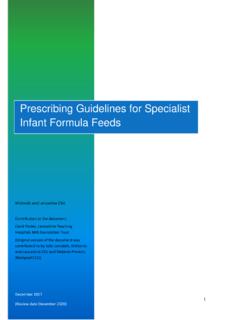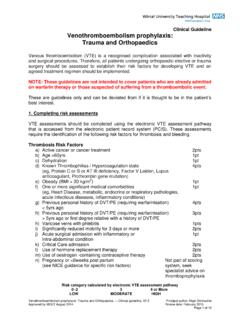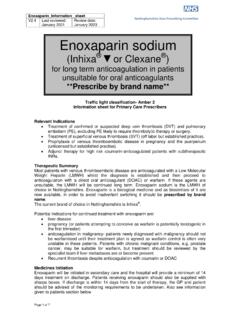Transcription of Low Molecular Weight Heparins (LMWHs) Summary …
1 Page 1 of 15 APPENDIX 1 Sharon Andrew Midlands & Lancashire CSU September 2019 (Review date September 2022) Low Molecular Weight Heparins (LMWHs) Summary Prescribing Guide Page 2 of 15 Version Control Contents 1. INTRODUCTION .. 3 2. PURPOSE AND Summary .. 3 3. SCOPE .. 3 4. GUIDANCE .. 4 Table 1. Overview of LMWH indications, locally agreed Colour Classifications, duration of treatment & licensing status .. 4 Dalteparin (Fragmin ) Dosing Chart .. 8 Enoxaparin (Clexane ) Dosing Chart .. 10 Tinzaparin (Innohep ) Dosing Chart .. 12 LMWH Monitoring Requirements .. 13 5. REFERENCES .. 15 Version Number Date Amendments made Prescribing checklist updated, check for contraindications added. Table 1. updated with local decisions regarding colour classification & information on bridging therapy Updated therapeutic indications and associated dosing regimens. Updated monitoring requirements.
2 Updated RAG ratings for GP/CSR Page 3 of 15 1. INTRODUCTION Historically, patients requiring subcutaneous anticoagulation have received treatment in secondary care. In recent years, Low Molecular Weight Heparins (LMWHs) have effectively replaced the routine use of unfractionated heparin in the majority of patients; and the potential for self-administration has led to an increased volume of prescribing in primary care. 2. PURPOSE AND Summary This guidance has been produced to facilitate the safe prescribing of LMWHs in primary care. It provides an overview of points to be considered when initiating LMWHs and when transferring prescribing responsibilities to or from another organisation. 3. SCOPE This is a Summary guidance document. It outlines general LMWH prescribing considerations and monitoring requirements. It also outlines points which should be communicated and agreed; when transferring prescribing responsibilities and the associated patient care between organisations.
3 This document does not provide guidance on the inpatient use of LMWHs or specific guidance on use in paediatrics or other specialist patient groups. For more information, prescribers should refer to the individual organisation s policy. Any decision around how a service operates and whether shared care is part of that commissioned service will be led by the commissioning organisation; clinicians should follow their locally agreed arrangements and not undertake in shared care unless a process has been defined. NB. For the purpose of this guidance the term Venous Thrombo Embolism (VTE) covers both Deep Vein Thrombosis (DVT) and Pulmonary Embolism (PE) Page 4 of 15 4. GUIDANCE Table 1. Overview of LMWH indications, locally agreed Colour Classifications, duration of treatment & licensing status1-3,6 Speciality Indication Duration of treatment Licensed Indication or Dalteparin Fragmin Enoxaparin Clexane Tinzaparin Innohep LMMG Colour Classification General Medical Treatment of VTE or suspected VTE in patients unable to stabilise on warfarin or DOACs or with a contraindication to warfarin or DOACs (For treatment of suspected VTE or for confirmed VTE whilst waiting for an oral vitamin K antagonist to be established see miscellaneous below).
4 1st DVT/PE: 3-6 months Previous DVT/PE: Lifelong If VTE confirmed: x x x Amber 1 Prophylaxis of DVT or PE when unable to stabilise on warfarin or DOACs, with an allergy or with contra-indication to warfarin and/or DOACs. (This includes IVDU patients) Lifelong with review of the need for anticoagulation at least annually (or more frequently if clinically relevant events occur affecting anticoagulation or bleeding risk) x x x Amber 1 Extended prophylaxis of high risk patients in the primary care setting Immobile patients or those deemed to be at particularly high risk of DVT at home or in a care situation and who are unable to tolerate/take warfarin or DOACs As per specialist advice, treatment should be reviewed if mobility improves and at least annually. (or more frequently if clinically relevant events occur affecting anticoagulation or bleeding risk) x x x Amber 1 Oncology Patients with solid tumours: Extended treatment of symptomatic venous thromboembolism (VTE) and prevention of its recurrence.
5 Note: LMWHs are used in preference to oral anticoagulation for the whole treatment course. Recommended duration of treatment is 6 months x Approved for off-label use by some local organisations Amber 1 Prophylaxis of VTE in oncology patients on VTE inducing therapy As per chemotherapy protocol/specialist advice x x x Red Obstetrics & Gynae13 Pregnancy: Treatment of VTE (pre and post-partum) As per specialist advice x x x Red Please note: Amber in Fylde Coast Amber 1 in Greater Preston and Chorley & South Ribble post-partum only) Pregnancy: Prevention of VTE (High risk patients- pre and post-partum) As per specialist advice x x x Red (Amber in Fylde Coast) Page 5 of 15 Speciality Indication Duration of treatment Licensed Indication or Dalteparin Fragmin Enoxaparin Clexane Tinzaparin Innohep LMMG Colour Classification Use by fertility clinics, and also to prevent miscarriage As per specialist advice x x x Red Surgical VTE Prophylaxis Post-operative use [ hips, knees, general surgical] Dependant on type of surgery and patient factors- follow local protocols/specialist advice Red All Surgical Specialities.
6 Post-operative use in conjunction with warfarin whilst waiting for the INR to come into range Until INR is in target range for at least 2 consecutive days If INR not in range at point of discharge follow advice on bridging therapy below Red Extended thromboprophylaxis of VTE for High Risk Patients with History of Thrombosis associated with central venous access On-going whilst central venous access required (For review if clinically events occur affecting anticoagulation relevant bleeding risk) x x x Red Travel11,12 Suggested for travel prophylaxis where travelling time is over 6 hrs in high-risk patients, patients with surgery in the previous 4 weeks requiring more than 30mins general anaesthesia, patients with known thrombophilia and patients with cancer As per specialist advice x x x Amber 0 Cardiology Unstable coronary artery disease (including non ST segment elevation myocardial infarction) For up to 8 days x Red Unstable coronary artery disease (including non ST segment elevation myocardial infarction) awaiting angiography or revascularisation and having already had 8 days of treatment of dalteparin Every 12 hours until the day of the procedure x x Red Treatment of acute ST segment elevation myocardial infarction (patients not undergoing percutaneous coronary intervention) Different treatment schedules dependent on patient age see table x x Red Treatment of acute ST segment elevation myocardial infarction (patients undergoing percutaneous coronary intervention) Different treatment schedules dependent on patient age see table x x Red Miscellaneous Bridging therapy for sub-therapeutic INRs It is expected that the organisation which initiates treatment or identifies the sub therapeutic INR, arranges for follow up INR testing and provides sufficient supply of LMWH and Warfarin to provide treatment until the follow up appointment.
7 The place of follow up will be determined by locally commissioned pathways, but where a secondary care organisation has provided the initial supply of LMWH and Warfarin it is anticipated that the on-going care and follow up will be transferred to a primary care organisation, unless otherwise inappropriate. Until INR is in target range for at least 2 consecutive days Dose and Licensing as per main Indication Amber 0 Page 6 of 15 Speciality Indication Duration of treatment Licensed Indication or Dalteparin Fragmin Enoxaparin Clexane Tinzaparin Innohep LMMG Colour Classification For suspected VTE or for confirmed VTE whilst waiting for an oral vitamin K antagonist to be established. At least five days of combined treatment is normally required. It is expected that the organisation which initiates treatment will continue to provide treatment until VTE has been excluded. Where VTE is confirmed, as outlined above re: bridging therapy the initiating organisation should provide the initial supply of LMWH and Warfarin and arrange for follow up INR testing (ensuring that the patient has sufficient supply of LMWH and Warfarin to provide the minimum treatment course and until the follow up appointment).
8 Until VTE excluded or if VTE confirmed: Dalteparin & Enoxaparin: At least 5 days and until an oral vitamin K antagonist has been established & the INR is in range for 2 days Tinzaparin: At least 6 days and until an oral vitamin K antagonist has been established & the INR is in range for 2 days Amber 0 (Amber 1 in Greater Preston and Chorley & South Ribble) Page 7 of 15 LMWH Prescribing Checklist When LMWH prescribing responsibility is being transferred from one organisation to another, it is essential that the points below are considered and supporting information is made available to the new organisation. Clinicians should follow their locally agreed arrangements and not undertake in shared care unless a process has been defined. LMWH Prescribing Checklist 4 Tick when complete 1. Indication: The indication for LMWH use is clear. There is no ambiguity regarding use for prophylaxis or treatment of VTE. 2. Contraindications: The patient has been assessed for pharmacological and clinical contraindications to the use of LMWHs.
9 LMWHs are only continued where the benefits of treatment outweigh the risks. Contra-indications include but are not limited to; active bleeding, thrombocytopenia, acquired bleeding disorders ( liver failure), severe hypertension, major trauma, concurrent use of interacting medicines, anticoagulants or antiplatelets. (See the SPCs for further information) 3. Licensing status of the medication/dose: The licensing status of the LMWH and prescribed dose has been considered. Where a medication is being used for an unlicensed indication or unlicensed dose, the rationale for use has been provided ( Ease of dosing/self-administration) or there is an organisational agreement to use off license preparations or doses. 4. Duration of treatment: The duration of treatment is known, this has been recorded and a system has been put in place to ensure that once the course is complete no further prescriptions are issued. It is good practice to put the stop-date on the prescription.
10 If the course length is dependent on the outcome of a clinical review, the prescription should be endorsed with the date of clinical review. 5. Dose: The dose is appropriate for the indication, Weight and renal function; and is measurable. It is good practice to write the dose on the prescription as the number of units or mg and to state the strength/volume to be injected, along with the size of syringe or vial to be supplied. (See dosing charts or the SPCs for further information) 6. Weight : The patient has been weighed and this Weight has been used to accurately calculate the dose. The Weight should be recorded in kilograms (kg)4, documented in the patient notes and on the prescription. Patients should be weighed periodically throughout treatment as appropriate4; for example if they are on prolonged treatment or if it is expected that their Weight may fluctuate. Specialist advice should be sought regarding dosing and monitoring of patients at extremes of Weight .










